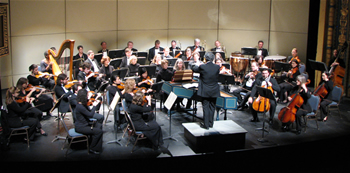St. Michael’s Episcopal Church in Raleigh was the scene of an inaugural organ recital by concert artist John Scott on the church’s recently-installed Nichols & Simpson pipe organ. Inaugural recitals provide the reviewer with a dual task. Both organ and performer share center stage and demand the reviewer’s attention.
John Scott, formerly of St. Paul’s Cathedral, London, and now at Saint Thomas Church, New York City, offered a program that both demonstrated the organ’s best properties and stretched its possibilities. E. M. Fagiani’s modern Veni Creator Spiritus opened the program with a set of creative and appropriately spirited variations on the Pentecost chant. J. P. Sweelinck’s Renaissance-era “Est-ce Mars?” gave us more variations to show the organ’s more intimate side. Scott gave G. F. Handel’s Concerto in F, Op. 4/5, a similarly expanded treatment, with the Nichols & Simpson serving as both orchestra and solo organ. J. S. Bach’s massive Prelude and Fugue in E-flat, S. 552, concluded the first half of the program with subdued eloquence. The second half opened with A. Guilmant’s “March on a Theme of Handel” (specifically “Lift up Your Heads” from Messiah but with even stronger overtures to “Caro mio ben”). César Franck’s “Cantabile” from Trois Pièces nicely showcased the organ’s foundation stops and the Trompette Harmonique of the Swell division. Duruflé’s moving but demanding “Prélude et Fugue sur le nom d’Alain” concluded the French portion of the program in grand style. Ad Wammes’s enchanting “Miroir” delighted the audience with a very different kind of contemporary piece. William Mathias’ Chorale and Recessional concluded the second half with a serenade and a romp respectively. A standing ovation brought Scott to the console for Norman Cocker’s “Tuba Tune” as an encore.
The new organ appears at first glance to be out-of-date with the church building, a contemporary take on French Colonial designed by Leif Valand and dedicated in 1954. Encased on both sides of the chancel and in the rear gallery, the organ’s divisions are fronted with narrow fields of large Principals that alternate between towers and flats. To my eyes, the casework truly harmonizes with the room, offering periodic tension between its own lines and the room’s vaulting, yet creating a satisfying resolution through thoughtful applications of color and texture, courtesy of designer Frank Friemel. The new three-manual console is movable, and it was placed where it and the performer were clearly visible to the audience.
The acoustical enhancements by Scott Riedel & Associates, Ltd. create a warm but not reverberant environment for music. The vast wooden ceiling affords an appreciable bass response, but the absence of hard reflective surfaces hampers projection of organ sound; the capacity crowd on hand no doubt affected the acoustical setting further. Tonally, the new organ owes much to the early 20th-century English organs, with elements of the American comprehensive design that is very much in vogue. From my seat toward the rear of the nave, the organ had an understated grandeur; only the commanding horizontal Festival Trumpet mounted on the rear-gallery case could be termed “loud.” Differentiation between right-hand and left-hand ensembles in the Handel was non-existent where I sat. Sufficient basses undergird clear, if somewhat sterile, flue and reed ensembles. The mixtures are held in check but the mutation stops have plenty of presence. Solo stops range from the quintessential Tuba necessary on English-inspired organs, to the surprisingly few imitative reed voices (Hautbois, Vox humana, Clarinet) and several intimate flute stops. The Pedal division’s three 32-foot stops have enough presence without swamping the ensemble or rattling the bones.
John Scott’s versatility and command were evident throughout the recital. He chose registrations that not only demonstrated the organ’s tonal resources but showed a genuine affection for his audience. He further engaged his listeners with brief but informative remarks. His controlled lyricism in the Franck “Cantabile” and Mathias “Chorale” was the epitome of mature, self-assured performance. He met head-on all the challenges that the pieces by Bach and Duruflé threw his way. His embellishments in the Handel were executed with unparalleled finesse. Most apparent, however, was how he truly understood this organ, chose his program, and shaped his playing with an ear toward what the organ does best. It would be difficult to imagine a better match between player and instrument. Bravo!











